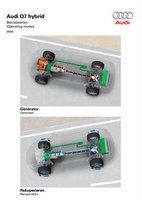SPY ----> Audi Q7 Hybrid car

 More photos --> Click here
More photos --> Click hereHybrid technology cars is getting popular since Gasoline price had been increasing rapidly recently. Let's have a look on Audi Hybrid technology. Full report
It is a concept Car SUV:
Length x Width x height: 5086 x 1983 x 1737 mm
Wheel base: 3002 mm
Gross Vehicle weight: 2410 kg
Mass Pro: Dedut in 2008 predicted.
Engine:
Gasoline engine: V8 FSI Direct Injection 16V DOHC.
Engine capacity (cc): 4163cc
Rated Output (kw): 257 at 6800rpm
Torque (Nm): 440 at 3500rpm
Electric Motor:
Rated Output (kw): 32
Torque (Nm): 200
Transmission: 6-speed AT Tiptronic
Drive: "Quattro" AWD with torsion differential. That's why its called "Q7" as pet name.



Driveline integration: The electric motor is integrated between the engine and the AT's torque converter, which linked up to engine via separating clutch that allows vehicle to be propelled by either one of the drive units alone or by oth acting in unison. This combination will give us 200Nm torque and 32Kw power.

The electric motor draws energy from BATTERY System beneath the trunk floor, together with a voltage transducer that supplies power to the electrical system. The Battery is Nickel-metel hydride (NiMH) type, the gross weight plus engine is about 140kg. (less than 7% of the total vehicle gross weight)

A electronic Control unit are required to coordinate operation of the two power units: Driver's commands, vehicle speed, battery's charge status and the pulses transmitted by the ESP are vital parameters. Electronics regulate the interaction between the drive components and convert the driver's comands, the occupants can follow what's happening in one of the sub-menus in the MMI display.
Petrol engine: Responsible for basic vehicle operation, although it also energises the battery at the same time.
Electric motor: Capable of propelling vehicle at speeds of up to 30km/h. Battery's charge capacity allows for a range of up to 2Km in pure electric mode, with the extra energy produced during braking and engine over running being fed back into system. Once the battery's capacity has dropped to minimum, the combustion engine cuts in to recharge it. The electric motor's thrust, with up to 200Nm of torque, is available instantly when the vehicle pulls away - with the electric motor's boost effect gaining 0.6s for the 0-100km/h sprint. The electric motor also regenerates the kinetic engergy produced by braking or driving downhill in overrun mode and feeds it back into the system to recharge the battery. During this "recuperation" phase, the unit switches its function in a fraction of a second to act as a generator, without the driver noticing.
Combustion engine Switch off: If vehicle is coasting without accelerator pedal depressed. The same fuel-saving measure is initiated whenever the vehicle is stationary ofr over 3s. To resume journey: Release brake pedal and depress accelerator. The electric motor assumes the role of the starter-alternator unit, resulting in a quiet, smooth and quick starting process.
Fuel consumption: 13% less fuel than a comparable standard-production model fitted with a combustion engine only. Average in the MVEG cycle is 12L per 100km.
Sunlight as energy source: Solar cells integrated in glass sunroof -which allow the HVAC to be operated during parking (Climate control system can be activated remotely a few minute before starting)




0 Comments:
Post a Comment
<< Home